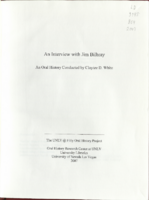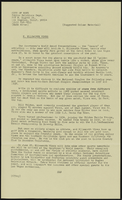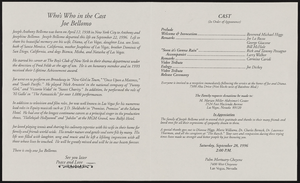Search the Special Collections and Archives Portal
Search Results
Robert "Bob" Agonia oral history interview
Identifier
Abstract
Oral history interview with Robert “Bob” Agonia conducted by Marcela Rodriguez-Campo on September 6, 2018 for the Latinx Voices of Southern Nevada Oral History Project. Agonia recalls his community being very diverse, with families sharing Filipino and Mexican American heritage and his neighbors being Japanese Americans. Agonia also discusses the role he played in starting the University of Nevada Las Vegas (UNLV) engineering school, and helping start a Minority Engineering Program at UNLV. He then speaks about Latino community involvement in Las Vegas, Nevada.
Archival Collection
Rick Peppers oral history interview
Identifier
Abstract
Oral history interview with Rick Peppers conducted by Claytee D. White on July 06, 2016 for the Boyer Early Las Vegas Oral History Project. In the interview, Peppers describes his childhood in Exira, Iowa and moving to Blue Diamond, Nevada in 1962. He explains working in various positions at the Blue Diamond Mine to ensure employment stability. Peppers shares stories about how the mine company's ownership of Blue Diamond affected the town. After transitioning into security jobs, he explains working through the Teamsters Union at the Aladdin Hotel and Casino, and then working forty-six years at Caesars Palace Hotel and Casino in Las Vegas, Nevada.
Archival Collection
James H. Bilbray oral history interview
Identifier
Abstract
Oral history interview with Jim Bilbray conducted by Jeff van Ee on March 26, 2009 for the Boyer Early Las Vegas Oral History Project. Bilbray first outlines his life from high school, to enlistment in the Army Reserve, attending American University, and working for Nevada Senator Howard Cannon. He then speaks of the different political philosophies in Northern Nevada versus Southern Nevada, the thinking in the mining industry, Sagebrush Rebellion, federal ownership of 86% of Nevada, the doughnut hole around the valley, Bureau of Land Management, hearings on environmental matters, taxation, and grazing laws.
Archival Collection
Evel Knievel oral history interview
Identifier
Abstract
Oral history interview with Evel Knievel conducted by David G. Schwartz on May 17, 2007 for the Remembering Jay Sarno Oral History Project. In this interview, Knievel discusses his personal relationship with Jay Sarno. He talks about Sarno’s career in gaming and the business ventures that he was involved with in Las Vegas, Nevada. Knievel recalls anecdotes of their friendship, and the opening of Caesars Palace Hotel and Casino, and Circus Circus Hotel and Casino. Lastly, he recalls stories of gambling with Sarno at his casinos.
Archival Collection
Church, Robert, 1974 April 17
Level of Description
Archival Collection
Collection Name: Frank Mitrani Photographs
Box/Folder: Box 10
Archival Component

Transcript of interview with Jim Bilbray by Claytee D. White, September 6, 2006
Date
Archival Collection
Description
Text
Count Guido Roberto Deiro oral history interview
Identifier
Abstract
Oral history interview with Count Guido Roberto Deiro conducted by David G. Schwartz on January 30, 2002 and November 22, 2017 for the Boyer Early Las Vegas Oral History Project. Deiro gives his personal recollections of living in Las Vegas, Nevada, including his father’s career, his upbringing, and fondest memories of the city.
Archival Collection
John E. Jeffrey oral history interview
Identifier
Abstract
Oral history interview with John E. Jeffrey conducted by Frank Vivirito on April 01, 1976 for the Ralph Roske Oral History Project on Early Las Vegas. Jeffrey discusses his occupational history, the disparity of work conditions and opportunities for Black and Mexican workers in the Henderson, Nevada magnesium plant, and his family’s medical history.
Archival Collection


